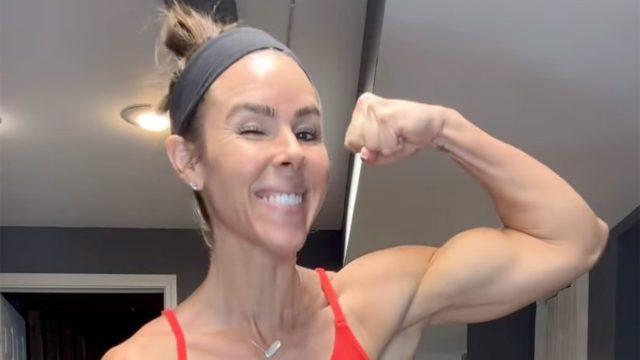Lose Fat Fast Over 40 with These 10 Habits, Says Expert

Are you over 40 and feeling like weight loss just isn't possible? That isn't the case, according to an expert. According to her Instagram bio, Sarah Gearino is a Nutrition, Fitness, & Hormone Expert who specializes in helping women over 40 achieve their fitness goals. In a new post, she explains her expert advice about slimming down. "If I wanted to lose fat fast as a woman 40+ without wrecking my metabolism, here are the 10 things I'd do," she writes in the post.
Increase Protein Intake
Her first suggestion is to increase your protein intake. "Aim for 30-40g of protein per meal to support muscle mass and satiety. Prioritize lean meats, eggs, fish, & plant-based sources," she suggests.
Strength Train 4-5x Per Week
Her next tip is to lift weights four to five times per week. "Focus on progressive overload with compound movements (squats, deadlifts, presses). More muscle = better metabolism," she says.
Walk 8,000-10,000 Steps Daily
It's no surprise that walking – 8,000 to 10,000 steps per day – is also on her list. "NEAT (Non-Exercise Activity Thermogenesis) is one of the biggest fat loss drivers without stressing your body. I got a walking pad and swear by it!" she says.
Prioritize Sleep (8-9 Hours)
Getting sleep – eight to nine hours per night – is also helpful. "Poor sleep wrecks hormones (cortisol, insulin, ghrelin) and increases cravings. Create a wind-down routine, avoid screens an hour before bed, and take magnesium," she says.
Stop Starving Yourself
Starving yourself won't help you lose weight in the long run. "Undereating = metabolic slowdown and muscle loss. A small 15-20% calorie deficit (not drastic cuts) is more sustainable," she writes.
Balance Blood Sugar & Cook All Meals
Keep your blood sugar balanced and ensure healthy eating by cooking for yourself. "Eat protein + fiber + healthy fats at each meal to avoid crashes and cravings. Use blood sugar hacks such as eating fiber first," she suggests.
Cycle Carbs Based on Activity
You should also practice carb-cycling based on your workout. "Higher carb on strength training days (sweet potatoes, fruit, cassava). Lower carb on rest days (but still get fiber-rich veggies)," she says.
Manage Stress/Cortisol
Managing stress and cortisol levels plays a significant role in fat loss. "Chronic stress keeps cortisol high, leading to belly fat storage. Daily deep breathing, walks, adaptogens, and magnesium help," she says.
Prioritize Strength Over Endless Cardio
Put your focus on strength training over cardio. "Too much cardio can burn muscle & slow metabolism. 2 short 15 min HIIT sessions/wk are great for fat loss without excess stress," she says.
Properly Fuel Pre & Post-Workout
Make sure you fuel your body before and after exercise. "Eat protein + carbs before & after workouts to preserve muscle & improve recovery. Fasted workouts can backfire if stress is already high. In the least, drink BCAA's before & after if you don't want to eat," she says.
Surround Yourself with Like-Minded People
One last suggestion? "Surround yourself with like-minded people who have the same goals. This goes a long way," she promises. And if you enjoyed this article, take advantage of these 15 Quick Ways to Lose Body Fat Percentage in a Week.




